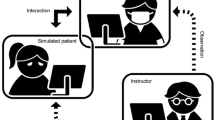Abstract
Design
A randomised controlled trial (RCT) was conducted in a dental school in Belgium.
Intervention
Undergraduate dental students were randomly assigned to a learner-control, multimedia learning-environment, courseware package (module) or the same module but structured in a program-control form. The learning objectives of learner- and program-control versions of the appliances module were identical. Both groups received the same materials covering the principles of orthodontic appliances that are normally provided at this stage of the undergraduate orthodontic curriculum. Both modules have didactic, interactive and simple animation components.
Outcome measure
Students were evaluated by means of a 15-item multiple-choice test covering knowledge, understanding and application. They were carried out at baseline and 15 min after finishing studying the modules. The tests were assessed by calculating the total score of the correct answers.
Results
Of 39 undergraduate dental students invited to take part, 30 students participated, 15 in each group. There was no significant difference in prior knowledge in the groups at baseline. Although both groups significantly improved their scores after studying the course, no significant difference was found between both groups in relation to answers to questions about knowledge, understanding and application.
Conclusions
In this study, the learner-control instructional multimedia program was found to be as effective as the program-control version when teaching principles of the orthodontic appliances to undergraduate students. Future work should focus on how to improve the value of computer-assisted learning (CAL), and comparative evaluations are still needed of how different CAL approaches compare with or complement one another.
Similar content being viewed by others
Commentary
This RCT of two different versions of a CAL package finds no difference in the knowledge gain between the two groups. In fact, the post-test scores in both groups were identical at 6.2 out of 15, a knowledge gain — perhaps disappointingly — of just 3 marks.
This study compares two CAL modules developed to allow the participants, in this case undergraduate dental students, different learning experiences to assess how this influences the knowledge gain, as assessed by a test comprising 15 question multiple-choice questions. In one style, the learner is to complete each section in sequence before being allowed to progress to the next (program-control version), whereas in the other style the learner is able to approach the sections in whichever order they wish (learner-control version). Other than the level of control, the CAL packages are identical, and within each topic both groups are able to navigate freely.
It is not surprising that no difference was found between the groups for a number of reasons. The material examined was identical, and in fact the student tracking showed those in the learner-control group tended to follow the logical sequence, working from top to bottom, which is the program-control sequence. The students were tested immediately after a set period of use and the test used was a knowledge-based multiple-choice questionnaire which would not detect any deeper learning outcomes achieved by the learner-control group, but would instead reflect memorisation. Perhaps most importantly, the existing evidence for educational interventions comparing didactic teacher-controlled learning with enquiry-based student controlled learning do not show differences in knowledge gain despite larger numbers and more clear cut differences in the interventions.
Where students are given greater control over their learning it is the difficult to measure outcomes in the areas where the differences in learning seem to lie: the learners′ perception of the process, the long-term knowledge retention, the revisiting of the learning resource, or the depth of understanding. The challenge is to provide the evidence of these additional gains and that they are at no cost to the knowledge gained.
Author information
Authors and Affiliations
Additional information
Address for correspondence: Professor Dr G Willems, Department of Orthodontics, School of Dentistry, Oral Pathology and Maxillofacial Surgery, Faculty of Medicine, Katholieke Universiteit Leuven, Kapucijnenvoer 7, B-3000 Leuven, Belgium. E-mail: guy.willems@med.kuleuven.ac.be
Aly M, Elen J, Willems G. Learner-control vs. program-control instructional multimedia: a comparison of two interactions when teaching principles of orthodontic appliances. Eur J Dent Educ 2005; 9:157–163
Rights and permissions
About this article
Cite this article
Bearn, D. A learner-control instructional multimedia program is as effective as a program-control version in undergraduate orthodontic teaching. Evid Based Dent 8, 18 (2007). https://doi.org/10.1038/sj.ebd.6400470
Published:
Issue Date:
DOI: https://doi.org/10.1038/sj.ebd.6400470
This article is cited by
-
Effects of dental 3D multimedia system on the performance of junior dental students in preclinical practice: a report from China
Advances in Health Sciences Education (2009)



